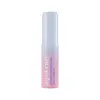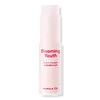What's inside
What's inside
 Key Ingredients
Key Ingredients

 Benefits
Benefits

 Concerns
Concerns

 Ingredients Side-by-side
Ingredients Side-by-side

Water
Skin ConditioningOctyldodecanol
EmollientCaprylic/Capric Triglyceride
MaskingSynthetic Wax
AbrasiveHydrogenated Polydecene
EmollientHelianthus Annuus Seed Oil
EmollientIsononyl Isononanoate
EmollientCopernicia Cerifera Wax
Butylene Glycol
HumectantDiisostearyl Malate
EmollientSimmondsia Chinensis Seed Oil
EmollientJojoba Esters
EmollientPolyglyceryl-4 Isostearate
EmulsifyingCoco-Caprylate/Caprate
EmollientSodium Chloride
MaskingSilica
AbrasiveSorbitan Isostearate
EmulsifyingPolyglyceryl-3 Polyricinoleate
EmulsifyingGlyceryl Caprylate
EmollientDisteardimonium Hectorite
StabilisingCaprylyl Glycol
EmollientTocopheryl Acetate
AntioxidantEthylhexylglycerin
Skin ConditioningCandida Bombicola/Glucose/Methyl Rapeseedate Ferment
AntimicrobialOryza Sativa Germ Oil
EmollientGlycerin
HumectantPolyglyceryl-2 Triisostearate
EmulsifyingAscorbic Acid
AntioxidantLavandula Angustifolia Flower/Leaf/Stem Extract
MaskingCamellia Sinensis Leaf Extract
Antimicrobial1,2-Hexanediol
Skin ConditioningAloe Barbadensis Leaf Extract
EmollientAvena Sativa Meal Extract
SoothingLepidium Meyenii Root Extract
Skin ConditioningMyrtus Communis Extract
AstringentSalvia Hispanica Seed Extract
EmollientAdansonia Digitata Seed Extract
Skin ConditioningViola Tricolor Extract
EmollientPrunus Domestica Fruit Extract
MoisturisingOphiopogon Japonicus Root Extract
Skin ConditioningSaussurea Involucrata Extract
HumectantOryza Sativa Bran Extract
Skin ConditioningNymphaea Alba Root Extract
Skin ConditioningLens Esculenta Seed Extract
Skin ProtectingNelumbo Nucifera Root Extract
Skin ConditioningHibiscus Esculentus Fruit Extract
Skin ConditioningLithospermum Erythrorhizon Root Extract
Skin ConditioningDioscorea Japonica Root Extract
Skin ConditioningAnthemis Nobilis Flower Extract
MaskingCocos Nucifera Fruit Extract
EmollientSalicornia Herbacea Extract
Skin ConditioningAstragalus Membranaceus Root Extract
EmollientCorchorus Olitorius Leaf Extract
Skin ConditioningGrifola Frondosa Fruiting Body Extract
EmollientHyaluronic Acid
HumectantTremella Fuciformis Extract
HumectantParfum
MaskingCI 42090
Cosmetic ColorantCI 17200
Cosmetic ColorantWater, Octyldodecanol, Caprylic/Capric Triglyceride, Synthetic Wax, Hydrogenated Polydecene, Helianthus Annuus Seed Oil, Isononyl Isononanoate, Copernicia Cerifera Wax, Butylene Glycol, Diisostearyl Malate, Simmondsia Chinensis Seed Oil, Jojoba Esters, Polyglyceryl-4 Isostearate, Coco-Caprylate/Caprate, Sodium Chloride, Silica, Sorbitan Isostearate, Polyglyceryl-3 Polyricinoleate, Glyceryl Caprylate, Disteardimonium Hectorite, Caprylyl Glycol, Tocopheryl Acetate, Ethylhexylglycerin, Candida Bombicola/Glucose/Methyl Rapeseedate Ferment, Oryza Sativa Germ Oil, Glycerin, Polyglyceryl-2 Triisostearate, Ascorbic Acid, Lavandula Angustifolia Flower/Leaf/Stem Extract, Camellia Sinensis Leaf Extract, 1,2-Hexanediol, Aloe Barbadensis Leaf Extract, Avena Sativa Meal Extract, Lepidium Meyenii Root Extract, Myrtus Communis Extract, Salvia Hispanica Seed Extract, Adansonia Digitata Seed Extract, Viola Tricolor Extract, Prunus Domestica Fruit Extract, Ophiopogon Japonicus Root Extract, Saussurea Involucrata Extract, Oryza Sativa Bran Extract, Nymphaea Alba Root Extract, Lens Esculenta Seed Extract, Nelumbo Nucifera Root Extract, Hibiscus Esculentus Fruit Extract, Lithospermum Erythrorhizon Root Extract, Dioscorea Japonica Root Extract, Anthemis Nobilis Flower Extract, Cocos Nucifera Fruit Extract, Salicornia Herbacea Extract, Astragalus Membranaceus Root Extract, Corchorus Olitorius Leaf Extract, Grifola Frondosa Fruiting Body Extract, Hyaluronic Acid, Tremella Fuciformis Extract, Parfum, CI 42090, CI 17200
Water
Skin ConditioningCeresin
Emulsion StabilisingCaprylic/Capric Triglyceride
MaskingIsodecyl Neopentanoate
EmollientDibutyl Adipate
EmollientButylene Glycol
HumectantCoco-Caprylate/Caprate
EmollientGlycerin
HumectantDipropylene Glycol
HumectantTocopheryl Acetate
AntioxidantEuphorbia Cerifera Wax
Synthetic Wax
AbrasiveSorbitan Sesquioleate
EmulsifyingStearyl Heptanoate
EmollientLauryl PEG-8 Dimethicone
Vinyl Dimethicone/Methicone Silsesquioxane Crosspolymer
Lauryl PEG-10 Tris(Trimethylsiloxy)Silylethyl Dimethicone
Emulsifying1,2-Hexanediol
Skin ConditioningSodium Chloride
MaskingStearyl Caprylate
EmollientGlyceryl Behenate/Eicosadioate
EmollientGlyceryl Caprylate
EmollientBisabolol
MaskingParfum
MaskingEclipta Prostrata Extract
Skin ConditioningStearalkonium Hectorite
Gel FormingPropylene Carbonate
SolventMelia Azadirachta Leaf Extract
Skin ConditioningMoringa Oleifera Seed Oil
EmollientMethylpropanediol
SolventTocopherol
AntioxidantPrunus Persica Fruit Extract
AbrasiveCollagen
MoisturisingLeuconostoc/Radish Root Ferment Filtrate
AntimicrobialHibiscus Sabdariffa Flower Extract
Skin ConditioningPrunus Persica Flower Extract
MoisturisingSaccharomyces Ferment Filtrate
HumectantPrunus Persica Leaf Extract
EmollientWater, Ceresin, Caprylic/Capric Triglyceride, Isodecyl Neopentanoate, Dibutyl Adipate, Butylene Glycol, Coco-Caprylate/Caprate, Glycerin, Dipropylene Glycol, Tocopheryl Acetate, Euphorbia Cerifera Wax, Synthetic Wax, Sorbitan Sesquioleate, Stearyl Heptanoate, Lauryl PEG-8 Dimethicone, Vinyl Dimethicone/Methicone Silsesquioxane Crosspolymer, Lauryl PEG-10 Tris(Trimethylsiloxy)Silylethyl Dimethicone, 1,2-Hexanediol, Sodium Chloride, Stearyl Caprylate, Glyceryl Behenate/Eicosadioate, Glyceryl Caprylate, Bisabolol, Parfum, Eclipta Prostrata Extract, Stearalkonium Hectorite, Propylene Carbonate, Melia Azadirachta Leaf Extract, Moringa Oleifera Seed Oil, Methylpropanediol, Tocopherol, Prunus Persica Fruit Extract, Collagen, Leuconostoc/Radish Root Ferment Filtrate, Hibiscus Sabdariffa Flower Extract, Prunus Persica Flower Extract, Saccharomyces Ferment Filtrate, Prunus Persica Leaf Extract
Ingredients Explained
These ingredients are found in both products.
Ingredients higher up in an ingredient list are typically present in a larger amount.
1,2-Hexanediol is a synthetic liquid and another multi-functional powerhouse.
It is a:
- Humectant, drawing moisture into the skin
- Emollient, helping to soften skin
- Solvent, dispersing and stabilizing formulas
- Preservative booster, enhancing the antimicrobial activity of other preservatives
Butylene Glycol (or BG) is used within cosmetic products for a few different reasons:
Overall, Butylene Glycol is a safe and well-rounded ingredient that works well with other ingredients.
Though this ingredient works well with most skin types, some people with sensitive skin may experience a reaction such as allergic rashes, closed comedones, or itchiness.
Learn more about Butylene GlycolThis ingredient is an emollient, solvent, and texture enhancer. It is considered a skin-softener by helping the skin prevent moisture loss.
It helps thicken a product's formula and makes it easier to spread by dissolving clumping compounds.
Caprylic Triglyceride is made by combining glycerin with coconut oil, forming a clear liquid.
While there is an assumption Caprylic Triglyceride can clog pores due to it being derived from coconut oil, there is no research supporting this.
Learn more about Caprylic/Capric TriglycerideCoco-Caprylate/Caprate is created from fatty coconut alcohol, caprylic acid, and capric acid.
It is a lightweight emollient. Emollients create a thin barrier on the skin to trap moisture in. This helps keep your skin hydrated and soft.
Once applied, Coco-Caprylate/Caprate is absorbed quickly and leaves a silky feel.
Coco-Caprylate/Caprate may not be fungal acne safe.
Learn more about Coco-Caprylate/CaprateGlycerin is already naturally found in your skin. It helps moisturize and protect your skin.
A study from 2016 found glycerin to be more effective as a humectant than AHAs and hyaluronic acid.
As a humectant, it helps the skin stay hydrated by pulling moisture to your skin. The low molecular weight of glycerin allows it to pull moisture into the deeper layers of your skin.
Hydrated skin improves your skin barrier; Your skin barrier helps protect against irritants and bacteria.
Glycerin has also been found to have antimicrobial and antiviral properties. Due to these properties, glycerin is often used in wound and burn treatments.
In cosmetics, glycerin is usually derived from plants such as soybean or palm. However, it can also be sourced from animals, such as tallow or animal fat.
This ingredient is organic, colorless, odorless, and non-toxic.
Glycerin is the name for this ingredient in American English. British English uses Glycerol/Glycerine.
Learn more about GlycerinGlyceryl Caprylate comes from glycerin and caprylic acid, a fatty acid from coconut. It has emollient and emulsifier properties.
As an emollient, it helps hydrate your skin. Emollients work by creating a barrier on your skin to trap moisture in, helping to keep your skin soft and smooth.
On the other hand, emulsifiers prevent ingredients (such as oil and water) from separating.
Learn more about Glyceryl CaprylateParfum is a catch-all term for an ingredient or more that is used to give a scent to products.
Also called "fragrance", this ingredient can be a blend of hundreds of chemicals or plant oils. This means every product with "fragrance" or "parfum" in the ingredients list is a different mixture.
For instance, Habanolide is a proprietary trade name for a specific aroma chemical. When used as a fragrance ingredient in cosmetics, most aroma chemicals fall under the broad labeling category of “FRAGRANCE” or “PARFUM” according to EU and US regulations.
The term 'parfum' or 'fragrance' is not regulated in many countries. In many cases, it is up to the brand to define this term.
For instance, many brands choose to label themselves as "fragrance-free" because they are not using synthetic fragrances. However, their products may still contain ingredients such as essential oils that are considered a fragrance by INCI standards.
One example is Calendula flower extract. Calendula is an essential oil that still imparts a scent or 'fragrance'.
Depending on the blend, the ingredients in the mixture can cause allergies and sensitivities on the skin. Some ingredients that are known EU allergens include linalool and citronellol.
Parfum can also be used to mask or cover an unpleasant scent.
The bottom line is: not all fragrances/parfum/ingredients are created equally. If you are worried about fragrances, we recommend taking a closer look at an ingredient. And of course, we always recommend speaking with a professional.
Learn more about ParfumChances are, you eat sodium chloride every day. Sodium Chloride is also known as table salt.
This ingredient has many purposes in skincare: thickener, emulsifier, and exfoliator.
You'll most likely find this ingredient in cleansers where it is used to create a gel-like texture. As an emulsifier, it also prevents ingredients from separating.
There is much debate on whether this ingredient is comedogenic. The short answer - comedogenic ratings don't tell the whole story. Learn more about comegodenic ratings here.
The concensus about this ingredient causing acne seems to be divided. Research is needed to understand if this ingredient does cause acne.
Scrubs may use salt as the primary exfoliating ingredient.
Learn more about Sodium ChlorideSynthetic Wax is created from fossil fuels such as natural gas. It is used to enhance texture, adjust pH, and as an occlusive.
It may also be used as an abrasive ingredient to exfoliate the skin.
Synthetic Wax may not be fungal acne safe.
Learn more about Synthetic WaxTocopheryl Acetate is AKA Vitamin E. It is an antioxidant and protects your skin from free radicals. Free radicals damage the skin by breaking down collagen.
One study found using Tocopheryl Acetate with Vitamin C decreased the number of sunburned cells.
Tocopheryl Acetate is commonly found in both skincare and dietary supplements.
Learn more about Tocopheryl AcetateWater. It's the most common cosmetic ingredient of all. You'll usually see it at the top of ingredient lists, meaning that it makes up the largest part of the product.
So why is it so popular? Water most often acts as a solvent - this means that it helps dissolve other ingredients into the formulation.
You'll also recognize water as that liquid we all need to stay alive. If you see this, drink a glass of water. Stay hydrated!
Learn more about Water